Public Bathhouse No. 7
Introduction
Text-to-speech Audio
The white brick building at 237-241 Fourth Avenue was constructed as a public bathhouse and was finished in 1910. It was the last of seven public baths established in Brooklyn. The Neo-Renaissance style building was converted into a gymnasium in 1937. Public Bath No. 7 was listed in the National Register of Historic Places in 1985. The building became a municipal gymnasium in the 1940s and closed in the 1970s. A transmission repair business next used the structure, and it was abandoned for some time. It housed The Lyceum or Brooklyn Lyceum, an events venue and cafe, from the 1990s until 2012. The building now is a private gym, the Park Slope branch of Blink Fitness.
Images
Public Bath No. 7/ Blink Fitness main facade along 4th avenue in 2020 photo (RayScript)
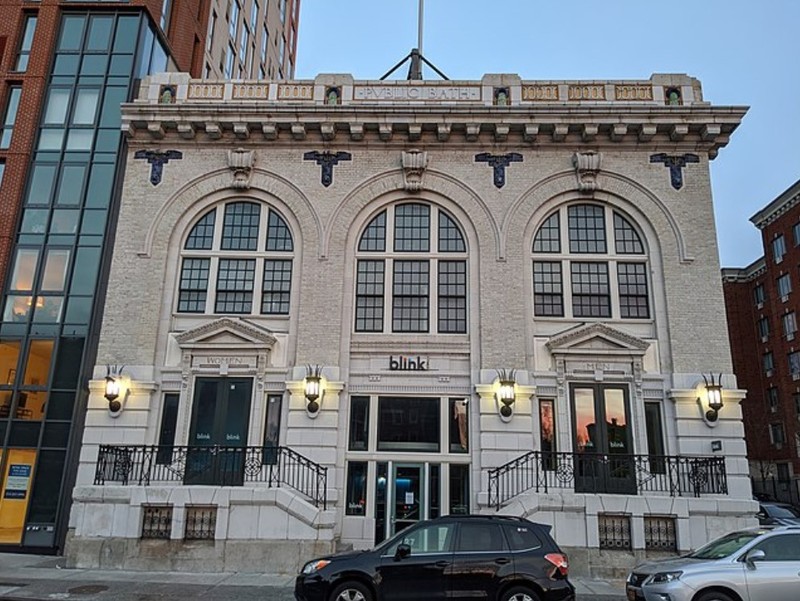
Public Bath No. 7, abandoned building, in 1985 photo (Joel Andree)
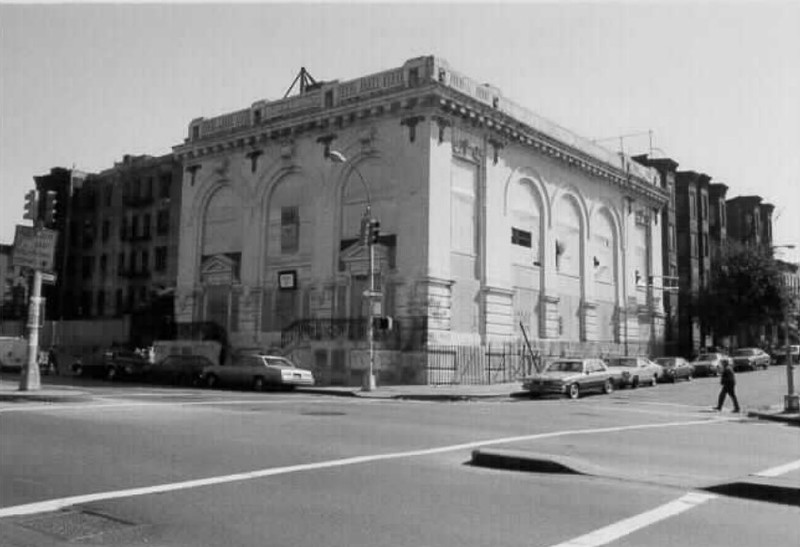
Detail of architectural decorations at upper corner of Public Bath No. 7 in 1985 (Andree)
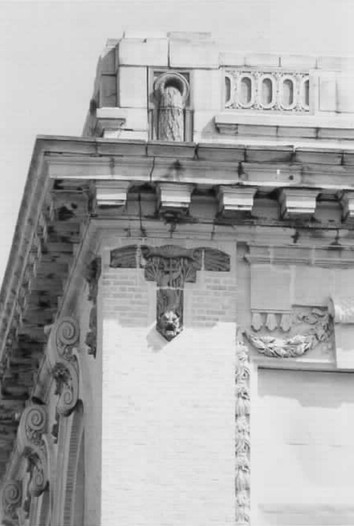
Abandoned gymnasium/ former pool area in Public Bath No. 7 (Andree 1985)
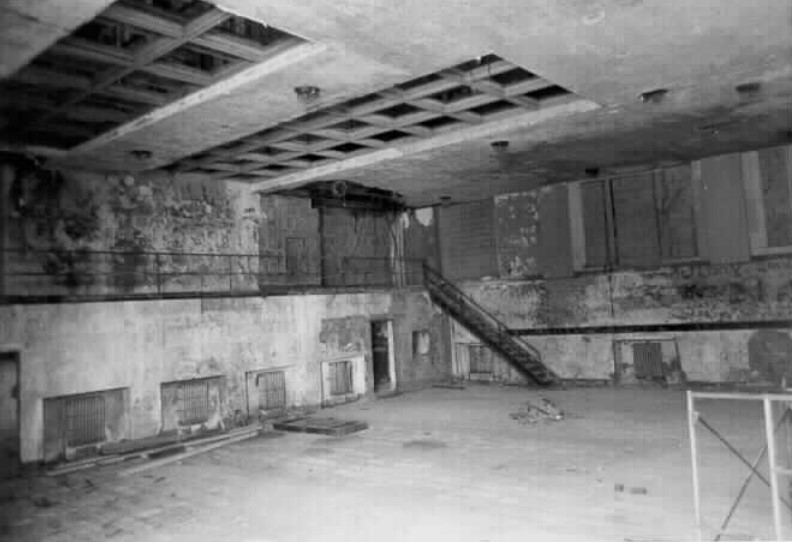
Interior of second floor facing 4th Avenue in 1985 photo (Andree)
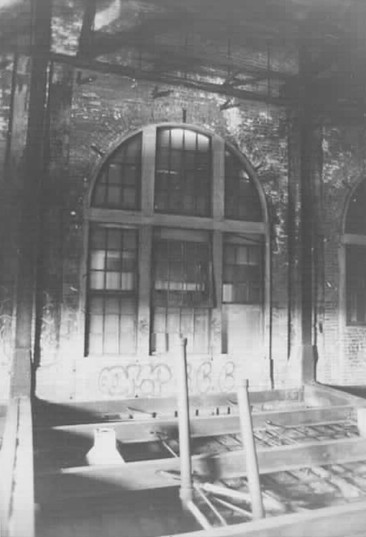
Backstory and Context
Text-to-speech Audio
Public bathhouses came about in New York City because tenement housing often had no running water or minimal water coming from rusty pipes. The first opened on Mott Street in 1851. Temporary bathhouses were open during the summers beginning in the 1870s. The city opened year-round public bathhouses in the 1880s, to encourage cleanliness and reduce disease outbreaks. Progressive reformers aimed to increase the social status of the poor and encourage upward mobility. The Association for Improving the Condition of the Poor recommended building bathhouses styled after ancient Roman architecture.
City of New York Mayor William Strong authorized a Subcommittee on Baths and Lavatories in 1895. In that same year, New York State passed regulations requiring the establishment of public baths in first and second-class cities. Public Bath No. 7 was the last of seven public baths built in Brooklyn. Buildings of two others in Brooklyn have survived :1752 Pitkin Ave. (closed in 1960) and Cowood Gliders on Huron St. (closed in 1949). When Public Bath No. 7 opened in 1910 it was the largest and most ornate of the seven bathhouses. The building was designed by Raymond F. Almirall (1869-1939); Almirall designed four Carnegie library buildings in Brooklyn (Bushwick, Eastern Parkway, Prospect, and Pacific).
Public Bath No. 7 featured separate entrances for men and women; you can still see the "MEN" and "WOMEN" inscriptions above the doorways. The outside is decorated with terra cotta dolphins, urns, and Triton (the father of the sea god Poseidon). The interior was laid out with a swimming pool and laundry in the basement; an atrium on the first floor overlooked the pool. First-floor offices had waiting rooms for men and women flanking them. Also on the main floor were 41 showers for men, 30 showers for women, and 9 tubs. The location of Public Bath No. 7 was chosen to be near the tenements of the Gowanus area, where many factory and dock workers and their families lived. It took four years to build. Tenement laws in New York City were enacted while this building was still being constructed, requiring installation of bathroom facilities in every new flat.
A Depression-era federal work project, the Works Progress Administration, completed some renovations of Brooklyn's public baths. The original soapstone stalls were replaced with marble enclosures, nonslip ceramic tile flooring was installed, and terra cotta and block partitions, shelves, and granite steps were built. Public Bath No. 7 closed in 1937. Some bathhouses later were converted into public swimming pools, like the Asser Levy Public Bath building in Kips Bay, which is now part of the Asser Levy Recreation Center.
The Brooklyn Lyceum, the occupant of the structure from the 1990s to 2012, hosted concerts and theater performances, and had a cafe. The building was lost to foreclosure and was auctioned off in February 2013.
Sources
Cory in North Brooklyn. Brooklyn Lyceum - Public Bath No. 7, Brooklyn Relics. February 23rd 2014. Accessed December 16th 2021. https://brooklynrelics.blogspot.com/2014/02/brooklyn-lyceum-public-bath-no-7.html.
Blink Fitness. Blink Fitness Park Slope, Blink. December 17th 2021. Accessed December 17th 2021. https://locations.blinkfitness.com/ny/brooklyn/227-fourth-avenue.
Hesch, Merrill. NRHP Nomination of Public Bath No. 7, Brooklyn, N.Y.. National Register. Washington, DC. National Park Service, 1985.
New York Historical Society. When and why did public bathhouses become popular?, Because History Matters. Accessed December 17th 2021. https://www.nyhistory.org/community/public-bathhouses-popular.
Rendon, Jim. Brooklyn Lyceum Slated for Auction, Brownstoner. February 5th 2013. Accessed December 16th 2021. https://www.brownstoner.com/real-estate-market/brooklyn-lyceum-slated-for-auction/.
Spellen, Suzanne. Building of the Day: 227 4th Avenue, Brownstoner. March 9th 2012. Accessed December 16th 2021. https://www.brownstoner.com/architecture/building-of-the-day-227-fourth-avenue/.
Young, Greg. Scenes from New York's public baths, The Bowery Boys: New York City History. Blog. March 19th 2018. Accessed December 16th 2021. https://www.boweryboyshistory.com/2018/03/scenes-new-yorks-public-baths-tenement-dwellers-got-clean-cool-alienist.html.
https://en.wikipedia.org/wiki/Public_Bath_No._7#/media/File:Public_Bath_No_7_in_Brooklyn,_April_2020.jpg
New York State Cultural Resource Information System (NYS CRIS): https://cris.parks.ny.gov/Default.aspx
NYS CRIS: https://cris.parks.ny.gov/Default.aspx
NYS CRIS: https://cris.parks.ny.gov/Default.aspx
NYS CRIS: https://cris.parks.ny.gov/Default.aspx
